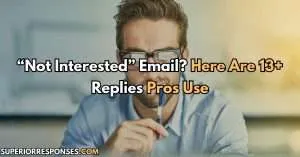Handling a response email where a prospective client states they are not interested anymore can certainly lower morale, especially if the interaction initially went well. It’s a powerful part of Email marketing—knowing how to respond effectively when facing an uninterested email.
Crafting the best possible response is a powerful part of continuing to interact and possibly convert a pre-qualified prospect into a committed client/customer.
Contents
- 1 Professional Replies When Someone Says “I’m not interested” Via Email”
- 2 Respectful Replies When Someone Says “I’m not interested” Via Email”
- 3 Questions To Understand The Underlying Reasons For Disinterest
- 4 How Often To Retry After An Initial Rejection?
- 5 Using Psychological Principles To Engage A Disinterested Client
Professional Replies When Someone Says “I’m not interested” Via Email”
- 1. “Thank you for letting me know! We appreciate your feedback and understand our offer might not be the right fit right now. If your needs change in the future, please think of us.”
- 2. “I appreciate your timely response. It helps us to save resources and better tailor our services.”
- 3. “That’s perfectly OK! I’m here to help if you change your mind or want to explore similar products that might better meet your needs.”
- 4. “Thanks for your feedback! Could you please share the reason why our product didn’t appeal to you? Your insights could be beneficial.”
- 5. “Thank you for your candor. We’ll keep your preferences in mind and hope to serve you under different circumstances.”
- 6. “Thank you for your response. We will not take more of your time today, but we remain enthusiastic about the possibility of working together in the future.”
Respectful Replies When Someone Says “I’m not interested” Via Email”
- 1. “Thanks for your response; it’s completely okay. I appreciate you taking the time to get back to me. If you ever need assistance or have any questions, feel free to reach out.”
- 2. “That’s totally fine. Thank you for your quick reply, and don’t hesitate to reach out if anything changes.”
- 3. “Your decision is respected, and I thank you for your honesty.”
- 4. “I respect your decision and wish you the best going forward.”
SUGGESTED: Top-Tier Replies To ‘I Will Get Back to You’ – Our Best 15
Questions To Understand The Underlying Reasons For Disinterest
- 1. “Can you share what aspects didn’t meet your expectations? Understanding your concerns better could help us improve.”
- 2. “Do you have suggestions on what could make our proposal more appealing to you in the future?”
- 3. “Was there something missing in our offer that you were hoping to see?”
- 4. “Is the timing not right, or are there other reasons you found our offer not suitable at this moment?”
- 5. “Are there specific results or outcomes you’re looking for that we didn’t cover?”

How Often To Retry After An Initial Rejection?
It’s generally a good idea to give the person some space—waiting a couple of weeks or even a month can prevent you from seeming pushy. This time allows your prospect to potentially reconsider your offer, or at least not feel overwhelmed by your eagerness.
If you have tried reaching out once or twice and still get a not interested reply, it might be best to stop there. Constant emails can annoy someone and undermine any chance of building a good relationship.
Think of how you would feel if someone keeps asking you to do something you don’t want; you’d likely become frustrated and pay less attention to them.
On the flip side, if the reply was soft, like “not now,” it suggests you might have a chance later—maybe a few months down the line.
It’s also a good idea to change what you said in the first email if you decide to try again. Time has passed and what didn’t catch their interest initially might have changed.
SUGGESTED: Professionally-Impactful “Sorry For Late Reply” Email Responses
Using Psychological Principles To Engage A Disinterested Client
Psychology plays a crucial role in how we understand and interact with potential clients.
When someone expresses disinterest, utilizing the foot-in-the-door technique can be effective. This method involves starting with a small request that’s easier to agree to. Once they say yes, you can gradually ask for a bit more.
For instance, instead of asking them to buy something, you might first offer something of value for free, like a guide or tips related to their business that could help them. This small yes could potentially lead to bigger yeses down the line.
It’s also beneficial to use personalization in your emails. Addressing someone by name and referencing specific details relevant to them makes your communication feel more personal and less like a bulk email.
For example, say “Hi [their name], I was thinking about your company’s recent challenge with X, and I thought this might help.”
Adding a touch of social proof can further enhance your message, such as mentioning how “Many folks find this resource helpful.”
Finally, remember that timing is important. Don’t rush to send another email immediately after a rejection. Wait a week or two, then check back with something genuinely helpful, not just another ask.
You May Also Like These:
23 “How Was Your Interview?” Replies They’ll Definitely Love

